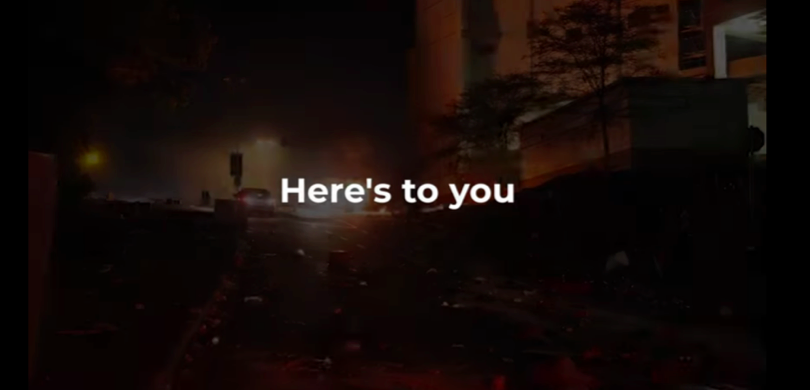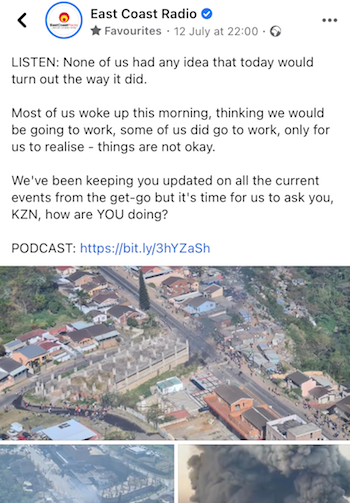The recent unrest in South Africa forced brands to act quickly and think smartly in order to create content to connect with their audience.
Emotions ran high as people were bombarded with images of looting and rioting in parts of KwaZulu-Natal and Gauteng. The need for trusted information grew as many people were uncertain about what was happening in their communities.
For many media brands, the crisis called for a re-evaluation of their content strategy. It also presented an opportunity for them to not only show their support for their community but showcase their brand values as well.
East Coast Radio reacted to the crisis immediately. The station adjusted its on-air and digital content daily as the story developed. The audience’s needs changed throughout the week-long unrest and every day was different.
When brands make content and messaging changes it should be based on research and insights. But when it comes to responding during crisis times, you must read the situation and trust your gut.
We immediately pulled a campaign celebrating Darren Maule’s 10 years as host of our Breakfast Show because the tone of a celebration was not right at the time.
Our listeners wanted to know about no-go areas, they wanted to understand if and how much trouble there was in their own neighbourhoods. Our traffic reports became even more important to our audience. A payoff line, ‘Here For You’, naturally evolved from a video we did and we used this during the week of the unrest and the looting.
We felt it articulated what we were trying to do perfectly.

Identifying the audience’s information needs
The audience’s need for updates throughout the unrest reflected in our podcast numbers. We saw an increase of 448% in podcast downloads driven by news and traffic, particularly from 5am to 8am. So, we started our reports from 4:30am, increased the frequency of the reports, and ensured we podcast them as quickly as possible for our web and app audiences.
Our streaming audio in that week was up on active sessions by 117% and in total we increased unique IPs for the week by 108%. On our website, page views were up 125%, average time on page was up 24%, and traffic to our news page was up 201%.
Visits to our audio streaming page was up by 163% and average concurrent traffic to the site was up by 400%. Anecdotally, we saw many of the interviews we conducted pop up on community WhatsApp groups, where the narrative was also that East Coast Radio is the go-to-place for updated reliable information.

The quality of a relationship that a brand has with its audience is built on the brand’s understanding of its audience’s needs.
Because we know the KwaZulu-Natal audience intimately and because we live through what they live through, we can pivot content in an instant to reflect what their needs are.
Our pursuit of reliable and factual information resonates with the audience and underpins the relationship that we have. We would much rather deliver information slightly later that is factual than be first with something that is potentially fake.
During a crisis, like we recently experienced, there were unmet needs in KwaZulu-Natal and East Coast Radio adjusted its content to align with those needs. Typically, our audience is looking for lots of music and light entertainment. During the recent riots they wanted regular, updated information and so that became our focus.
Handling negative feedback
A big challenge we faced during the period, was managing people’s expectations. A lot of South Africans were divided about the unrest, and we occasionally received negative feedback from the audience about certain stories.
We had to constantly monitor the sentiment on our social media channels. One of the biggest challenges as a media brand is that often the audience will not read an article or listen to a piece of audio.
They will simply see the post, read the headline, and make up their mind about the content without engaging it. Sometimes they will share the link or comment about the content and have it wrong. This is not uncommon, especially on a platform like Facebook.
This makes community management difficult, but we understand that different segments of our audience have different perspectives, and so not every piece of content will resonate with everyone.
Where threads become racist or inciteful, we manage it as our team sees fit. We do not tolerate racism, sexism, or any form of discrimination on our platforms. If we get it wrong, and we occasionally do, we will correct the content and apologise for the mistake.
We will then look at our procedures to see how a mistake crept in and improve them to avoid future mistakes.
It’s okay to admit when you are wrong
In a bid to help our community as much as possible, we tried several ideas, such as sharing the details of open shops and fuel stations, but we found that this was creating anxiety for people in those areas. So, we removed such listings from our website and our on-air product.

During times of crisis, some ideas may seem good in the moment, but if you find that they do not work, you need to be agile and change or stop them as quickly as you start them.
In the mix of all the chaos, we faced another challenge – fake news.
There was a lot of misinformation going around, and it was crucial that our editorial team combat fake news.
Fake news is the enemy of quality journalism around the world. Our editorial team works incredibly hard to get to the bottom of stories, especially those in the public interest. We similarly spend a lot of time verifying our facts.
It is never about pushing an agenda or angling a story to suit a particular view. I am reminded of a quote I heard in a TV show called ‘Truth Be Told’, in which they quote journalist Ian Bradley, and it rings true when it comes to dealing with the opposite of fake news, which is the truth: “As long as a journalist tells the truth in conscience and fairness, it’s not his job to worry about consequences”.
Our editorial team is empowered to tell the truth and to do their work with no interference.
Using music to inspire
During the peak of the riots, we had two things we needed to do. Provide our audience with the information that they needed on the spot and to also be a source of comfort and hope. The former we did through delivering reliable updated information on air, online, and on social media.
The latter was done through the power of music. According to Medical News Today, music impacts the volumes of stress hormones, such as adrenaline and cortisol in the body and reducing them relieves symptoms of anxiety.
As the riots began to unfold and our audience’s anxiety levels increased, we tweaked our playlist and played music that was uplifting and that inspired hope.
Leading with empathy
Leading with empathy and genuinely understanding our audience’s needs helped us build better relationships. During a crisis like we have just experienced, it’s a lot easier to develop sincere empathy for your audience when you live through it together.
Just like our audience we had moments when we were scared, angry, anxious and confused and so the empathy we showed was real and it came from a place of deep understanding. This is not to say that brands based in other parts of the country didn’t show sincere empathy, but when you live through it, you have a much better sense of what is needed on the ground and because we’ve been through this together, we deepened our appreciation for what triggers our audience.
I am incredibly proud of every member of our team. We all got our hands dirty and stopped at nothing to deliver on our promise to KwaZulu-Natal.
We can claim to be here for you. We can claim to play music that creates hope and inspires. We can claim to deliver factual, unbiased news and information, but the truth is that if we truly do these things, it will be seen in how our audience engages us.
Based on the results we saw, quoted at the start of this article, I think it’s safe to say that we are here for all the beautiful people of our province.

Zane Derbyshire is currently the head of all things content and programming at East Coast Radio. He loves working with creative teams, is very results driven, and is passionate about developing people in the media and content space in South Africa.














